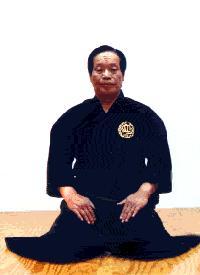 |
 |
 |
 |
 |
 |
 |
 |
 |
 |
 |
 |
 |
 |
 |
 |
 |
 |
 |
 |
 |
 |
 |
 |
|
|
Soke Teruo Hayashi
1924 - 2004 |
|
|
|
 |
|
|
|
|
|
|
 |
|
|
|
Untitled
|
|
|
|
|
|
|
|
|
|
|
Hayashi Teruo was the founder and active headmaster of Hayashi-Ha Shito-Ryu. His style is the result of over fifty years of research into numerous Okinawan and Japanese Karate styles Hayashi Soke has studied over his amazing lifetime. Starting in Osaka, Japan, the birthplace of Shito-Ryu, Hayashi Soke studied under Kosei Kuniba, a cheif disciple of Shito-Ryu's founder Kenwa Mabuni. Hayashi Soke studied briefly with Mabuni, but his daily instruction came from Kuniba, at least at first. It was not long before Hayashi outgrew the experience Osaka had to offer. Certainly there were many katas to learn and technique to be perfected, but what young Hayashi relished the most was a new challenge. From Osaka, an ambitious Hayashi set off to Okinawa to master the world, his opponents and himself. After all, his teacher came from Okinawa, his teacher's predecesor came from Okinawa the birth place of Karate. |
|
|
|
Hayashi aproached is selection of a Dojo to study at as extremely unorthodox. He would enter the Dojo and challenge the Sensei to a fight. This in turn would anger any students present at the time and they would insist on fighting Hayashi in order to teach Hayashi a lesson before their Sensei would reduce himself to accept a challenge from the upstart.
This practice, some migh consider brave, others foolish, is actually a time honoured tradition in Japanese and Okinawan cultures. It is known as Dojo Yaburi (challenge). While not practiced frquently these days, it was common protocol when Hayashi was a young man. The way it works is as follows: the man that issued the challenge must first fight the lowest ranking man in the Dojo. If the challenger defeats his opponent he is granted the right to fight the next lowest ranked man. This process is repeated until the challenger is defeated or has himself defeated the Dojo's Senpai (top student). then only is he allowed to challenge the Sensei himself, but is usually given the opportunity to choose the time and venue as a reward for his previous efforts. |
|
|
|
Hayashi became infamous for this practice, and as a result , very good at kumite. So much so that many Dojos refused his challenges and would not let him as far as the door. There were, of course, those that accepted. If Hayashi was beaten at on of these Dojo's he would ask to stay for training. It was this time honoured tradition that helped Hayashi seek not only knowledge, but respect from the Okinawans. |
|
|
|
As a result of his tenacity Hayashi was able to gather much experience while in Okinawa. His primary teachers in Okinawa were Nagamine Shoshin and Nakaima Kenko. From Sensei Nagamine he learned both the Shuri and Tomari lineages of Kata. These Katas emphasize long linear stances and quick motion between stances. It was from Nagamine that Hayashi learned the white crane form, Hakkaku. |
|
|
|
From Sensei Nakaima, Hayashi learned an obscure famnily art called Ryuei-Ryu. This style is a southern tiger style imported from China four generation prior to Hayashi's arrival in Okinawa. After a year of proving himself to the revered Nakaima, Hayashi was the first non-family member allowed to study the style. Hayashi incorporated much of Ryuei-Ryu's theory into his owm style. |
|
|
|
Upon returning to Japan, Hayashi continued his study with Kuniba Kosei. From Kuniba Hayashi learned the bulk of the Shito-Ryu syllabus, and as such it was the Shito-Ryu versions of the Naha Kata that Hayashi was taught . Hayashi was Kuniba's Senpai and it was on his death bed that Kubina asked Hayashi to head his organisation until his son, Shogo, reachead a level of maturity to assume leadership of the organisation. Honouring his Sensei's wishes, Hayashi became President ofthe Seishin-Kai until 1970 at which time he handed leadership to the styles rightful heir, Kuniba Shogo, and founded his own style, Hayashi-Ha Shito-Ryu. |
|
|
|
Untitled
Back to top
|
|
